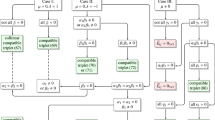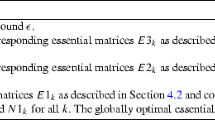Abstract
It is well known that without any priori knowledge on the scene, camera motion and camera intrinsic parameters, the only constraint between a pair of images is the so-called epipolar constraint, or equivalently its fundamental matrix. For each fundamental matrix, at most two independent constraints on the cameras’ intrinsic parameters are available via the Kruppa equations. Given N images, N(N−1)/2 fundamental matrices appear, and N(N−1) Kruppa constraints are available. However, to our knowledge, a formal proof of how many independent Kruppa constraints exist out of these N(N−1) ones is unavailable in the literature. In this paper, we prove that given N images captured by a pinhole camera with varying parameters and under general motion, the number of independent Kruppa constraints is (5N−9) (N > 2), and it is less than that of independent constraints from the absolute quadric by only one. This one-constraint-less property of the Kruppa equations is their inherent deficiency and is independent of camera motion. This deficiency is due to their failure of automatic enforcement of the rank-three-ness on the absolute quadric.
Similar content being viewed by others
References
Faugeras O, Luong Q, Maybank S. Camera self-calibration: Theory and experiments. In Proc. 2nd European Conference on Computer Vision, Santa Margherita Ligure, Italy, May, 1992, pp.321–334.
Hartley R, Zisserman A. Multiple View Geometry in Computer Vision. Cambridge University Press, 2000.
Hartley R. In defence of the 8-point algorithm. In Proc. 5th International Conference on Computer Vision, Massachusetts, USA, June 20–23, 1995, pp.1064–1070.
Zeller C, Faugeras O. Camera self-calibration from video sequences: The Kruppa equations revisited. Research Report 2793, INRIA, 1996.
Triggs B. Autocalibration and the absolute quadric. In Proc. IEEE Conference on Computer Vision and Pattern Recognition, Puerto Rico, USA, June 1997, pp.609–614.
Wu W T. Basic Principles of Mechanical Theorem Proving in Geometries. Volume I: Part of Elementary Geometries, Beijing: Science Press, 1984; Springer 1994.
Wu W T. Mathematics Mechanization. Science Press/Kluwer Academic, Beijing, 2000.
Sturm P. A case against Kruppa’s equations for camera self-calibration. In Proc. IEEE International Conference on Image Processing, Chicago, Illinois, October, 1998, pp.172–175.
Sturm P. A case against Kruppa’s equations for camera self-calibration. IEEE Trans. Pattern Analysis and Machine Intelligence, 2000, 22(10): 1199–1204.
Sturm P. Critical motion sequences for monocular self-calibration and uncalibrated Euclidean reconstruction. In IEEE International Conference on Computer Vision and Pattern Recognition, Puerto Rico, June, 1997, pp.1100–1105.
Pollefeys M, Koch R, Van Gool L. Self-calibration and metric reconstruction in spite of varying and unknown intrinsic camera parameters. In Proc. 6th International Conference on Computer Vision, Bombay, India, January 1998, pp.90–95.
Author information
Authors and Affiliations
Corresponding author
Additional information
This work was supported by the National Natural Science Foundation of China under Grant No. 60121302 and No. 60303021.
Zhan-Yi Hu received the Ph.D. degree (Docteur d’Etat) in computer science from the University of Liege, Belgium, in Jan. 1993. Since then, he has been with the Institute of Automation, Chinese Academy of Sciences. From May 1997 to May 1998, he also acted as a visiting scholar of Chinese University of Hong Kong. Dr. Hu now is a research professor of computer vision, a member of the Executive Expert Committee of the Chinese National High Technology R&D Program and an associate editor for Journal of Computer Science and Technology and Chinese Journal of CAD and CG. His current research interests are in robot vision, including camera calibration, 3D reconstruction, active vision, geometric primitive extraction, and vision guided robot navigation.
Yi-Hong Wu received her Ph.D. degree in geometric invariants and applications from MMRC, Institute of Systems Science, Chinese Academy of Sciences, in 2001. From June 2001 to July 2003, she did her postdoctoral research in NLPR, Institute of Automation, Chinese Academy of Sciences. After then, she joined NLPR as an associate professor. Her research interests include polynomial elimination and applications, geometric invariant and applications, automated geometric theorem proving, camera calibration, and 3D reconstruction, and object recognition.
Fu-Chao Wu received his B.S. degree in mathematics from Anqing Teacher’s College in 1982. From 1984 to 1994, he acted first as a lecturer then as an associate professor in Anqing Teacher’s College. From 1995 to 1999, he acted as a professor in Anhui University. Since 2000, he has been with the Institute of Automation, Chinese Academy of Sciences, where he is now a professor. His research interests are in computer vision, including 3D reconstruction, active vision, and image based modeling and rendering.
Song-De Ma received his Ph.D. degree from University of Paris 6 in 1983 and “Doctorat d’Etat es Science” from INRIA France in 1986 in image processing and computer vision. He was the invited researcher in Computer Vision Laboratory in the University of Maryland in USA in 1983 and Robot Vision Laboratory in INRIA, France from 1984 to 1986. From 1986 to 1988, he was the research professor and director of the National Pattern Recognition Laboratory of Institute of Automation, Chinese Academy of Sciences. Since 1996, he has been the president of the Institute of Automation, Chinese Academy of Sciences. He is the editor-in-chief of the Chinese Journal of Automation, associate editor of the International Journal of Pattern Recognition and Artificial Intelligence. His current research interests include image processing, 3D computer vision, robotics, computer graphics, and multimedia technology.
Rights and permissions
About this article
Cite this article
Hu, ZY., Wu, YH., Wu, FC. et al. The Number of Independent Kruppa Constraints from N Images. J Comput Sci Technol 21, 209–217 (2006). https://doi.org/10.1007/s11390-006-0209-3
Received:
Revised:
Issue Date:
DOI: https://doi.org/10.1007/s11390-006-0209-3




